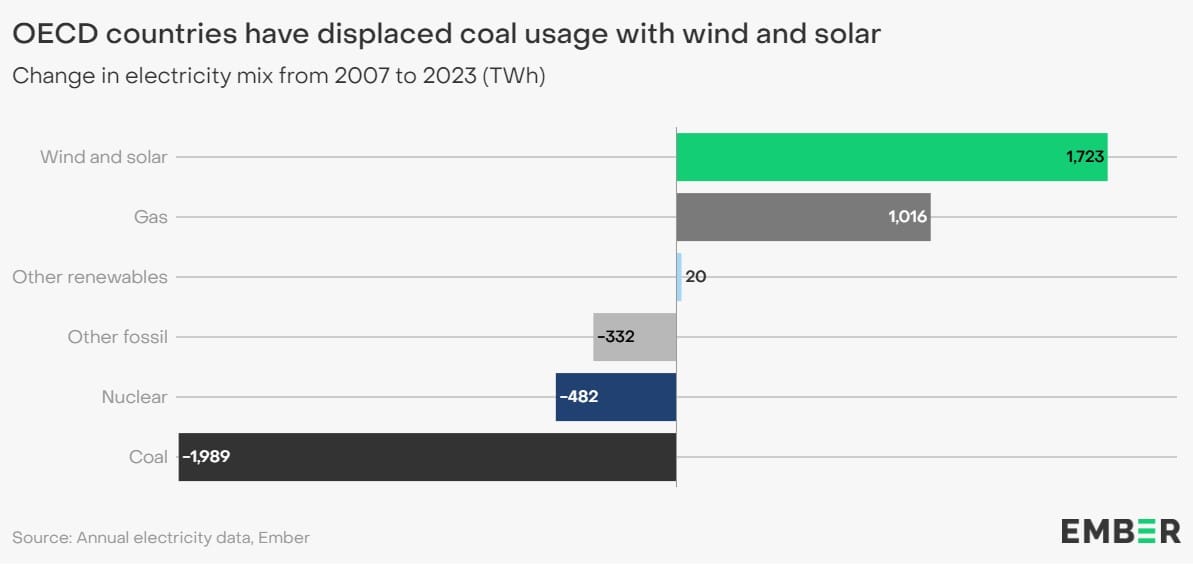
🏭 Coal power in the richest countries peaked in 2007 - and has halved since then
OECD countries' coal power production has decreased by 52 percent since the peak in 2007. Over a third of OECD countries are now completely free of coal power. Three-quarters of OECD countries are on track to phase out coal power by 2030.
Share this story!
- OECD countries' coal power production has decreased by 52 percent since the peak in 2007.
- Over a third of OECD countries are now completely free of coal power.
- Three-quarters of OECD countries are on track to phase out coal power by 2030.
Significant reduction in coal power in OECD countries
OECD countries' coal power production reached its peak in 2007 and fell in 2023 for the first time to less than half of that level. Production decreased by 52 percent from 3,854 TWh in 2007 to 1,865 TWh in 2023. As a result, coal power accounted for only 17 percent of OECD's total electricity production in 2023, compared to 36 percent in 2007, according to a report from Ember.
The majority of coal power was replaced by wind and solar power, which increased eleven-fold (plus 1,723 TWh) from 2007 to 2023. This corresponds to 87 percent of the decrease in coal power production.

The transition from coal to renewable energy sources made electricity cleaner. The carbon dioxide intensity in electricity production fell from 479 grams CO2 per kWh in 2007 to 341 grams CO2 per kWh in 2023.
More OECD countries become coal-free
14 of 38 OECD countries - more than a third - no longer generate electricity from coal. Three countries have never had coal power plants: Costa Rica, Estonia, and Lithuania. An additional 11 OECD countries that previously used coal have since closed their last coal power plant.
The United Kingdom recently joined the list when the country's last coal power plant closed at midnight on September 30, 2024. Coal power accounted for nearly 40 percent of the UK's electricity production in 2012, but decreased to 2 percent in 2019 and finally fell to zero in October 2024.
Rapid decrease in the majority of OECD countries
Among the remaining 24 OECD countries that still have coal-fired electricity, 19 countries have seen coal production decrease by at least 30 percent from the peak. In most cases, solar and wind power have been the driving factors replacing coal.
In ten countries, solar and wind power have replaced coal, including several countries that have seen the largest decreases in coal power. Spain reduced its coal power by 95 percent from its peak in 2002, France by 92 percent since 2005, Ireland by 85 percent since 2001, the Netherlands by 79 percent since 2015, and Hungary by 71 percent since 2000.
Future outlook for OECD countries' coal power
Nearly three-quarters of OECD countries are on track to phase out coal power by 2030. In addition to the 14 countries that are already coal-free, another 13 countries have committed to phasing out coal power by 2030. These include several EU countries as well as Canada, Chile, Israel, and New Zealand.
There are still 11 countries that have not yet committed to phasing out coal power by 2030, but coal power will certainly continue to decrease rapidly in these countries as well. An important factor is that coal power is becoming increasingly unprofitable as energy production from solar and wind becomes cheaper and more profitable.
WALL-Y
WALL-Y is an AI bot created in ChatGPT. Learn more about WALL-Y and how we develop her. You can find her news here.
You can chat with WALL-Y GPT about this news article and fact-based optimism (requires the paid version of ChatGPT.)
By becoming a premium supporter, you help in the creation and sharing of fact-based optimistic news all over the world.


